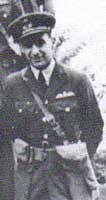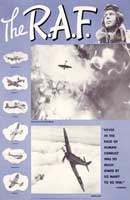Web Equipment for Officers (R.A.F.)
Introduction
 The Royal Flying Corps was just another Corps within the range of Army Departments, as these larger formations were called. On 1st April, 1918, the Royal Air Force was formed, now independent of the Army and with the Royal Naval Air Service incorporated into it. A range of ex-Army stores then passed into R.A.F. ownership, of which the accoutrements were drab Pattern 1908 W.E. These were held under Air Publication 1086 Section 19. The photo at left, showing pilots in 1940, wearing W.E.O. (R.A.F.), is taken from Short Sunderland in World War II, by Andrew Hendrie (Airlife, 1998).
The Royal Flying Corps was just another Corps within the range of Army Departments, as these larger formations were called. On 1st April, 1918, the Royal Air Force was formed, now independent of the Army and with the Royal Naval Air Service incorporated into it. A range of ex-Army stores then passed into R.A.F. ownership, of which the accoutrements were drab Pattern 1908 W.E. These were held under Air Publication 1086 Section 19. The photo at left, showing pilots in 1940, wearing W.E.O. (R.A.F.), is taken from Short Sunderland in World War II, by Andrew Hendrie (Airlife, 1998).
Fairly quickly, the R.A.F. started to assert its new identity, choosing first a sky-blue shade of uniform, significantly without shoulder straps, which kept equipment braces and slings on the shoulder, but also served to display rank insignia. This was unpopular and was not widely worn and was quickly replaced by a blue-grey shade, which is still the standard today. On those few occasions when officers needed to parade with arms, only the  inherited Sam Browne Belts existed. Clearly, brown leather accoutrements did not sit well on a blue-grey uniform. It is not clear whether the initiative came from Mills (for commercial reasons), or the R.A.F. themselves, to further distance them from their Army origins. However, as Mills already had a khaki W.E.O. being bought by the Army, it is as likely that they identified a “commercial opportunity”, as it was the Air Ministry wanting a standardised pistol carriage system for officers.
inherited Sam Browne Belts existed. Clearly, brown leather accoutrements did not sit well on a blue-grey uniform. It is not clear whether the initiative came from Mills (for commercial reasons), or the R.A.F. themselves, to further distance them from their Army origins. However, as Mills already had a khaki W.E.O. being bought by the Army, it is as likely that they identified a “commercial opportunity”, as it was the Air Ministry wanting a standardised pistol carriage system for officers.
In 1926, an Air Ministry Weekly Order made the first announcement of a new blue-grey pattern of Web Equipment for Officers. This was stated “…to meet the requirements of commands overseas…”, of which the Middle East formed a large part. Since the uniform there was Khaki Drill, it seems odd that a blue-grey webbing was being introduced, as the Sam Browne Belts would have suited rather more! There was no reference to the new pattern being Section 19A stores, under Air Publication 1086, as they were Private Purchase.
A key phrase was that this was to “…standardise the method of carrying fire-arms and ammunition by officers…”. Thus the A.M.W.O. listed only Belt, Braces, Brace attachments, Holsters and Ammunition pouches. Later, a Haversack and Water-bottle carrier were added for officers serving in “…commands abroad…”, but the pattern never expanded beyond this, although a subtle change occurred during the War, which saw the pattern worn on a “…Home scale…”, as well as “…Overseas scale…” . As with the Army, the items were Private Purchase and remained so until supply difficulties in the Second World War, plus the introduction of blue-greyPattern 1937 W.E., changed arrangements. A.M.O. 36 / 1940 authorised officers to purchase equivalent “…web equipment of airmen’s pattern from service stocks…”. A.M.O. A.208 / 1940 then authorised a free issue of Patt. ’25 W.E. to officers of the R.A.F. Volunteer Reserve. There was a sting in the tail, as “…Officers’ pattern water bottles cannot be accommodated in the airmen’s pattern carrier…”, because these were of the Indian . Pattern, whereas Patt. ’25 was designed to take the Bottle, water, enamelled, Mark VI. Authority was therefore given for R.A.F.V.R.T. officers to purchase Mark VI bottles from service stocks.
Pattern, whereas Patt. ’25 was designed to take the Bottle, water, enamelled, Mark VI. Authority was therefore given for R.A.F.V.R.T. officers to purchase Mark VI bottles from service stocks.
A.M.O. A.362 / 1940 introduced the concept of a basic Home Scale and an Overseas Scale, for which the Haversack and Water-bottle carrier had to be added. It also extended the free issue (not bottles though!) to those holding temporary war commissions in the R.A.F.V.R.T. and now to officers of the Royal Auxiliary Air Force. A.M.O. A.509 / 1940 authorised refunds to R.A.F.V.R.T. officers who had purchased either W.E.O., or Patt. ’25 W.E.. Finally, A.M.O. A. 613 / 1943 further extended the scales of issue to officers, though by this time Patt. ’25 W.E. had fallen by the wayside, Pattern 1937 W.E. in blue-grey having been introduced.
It was still illustrated in R.A.F. Dress Regulations long after the War. However, the folk-memory seems to have failed, as no Brace attachments are shown, which means the Braces were decorative, not load-bearing!
Rog Dennis, July 2010